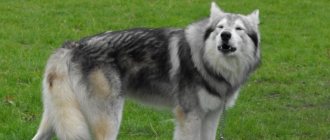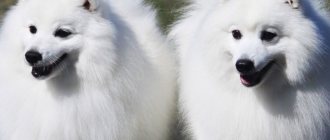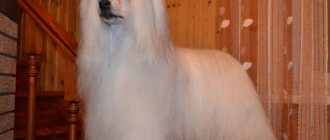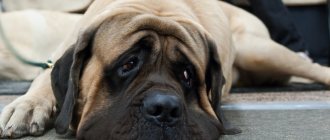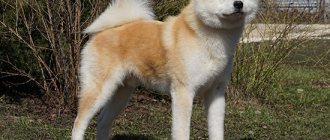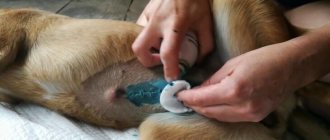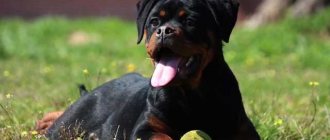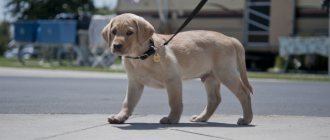- Shih Tzu
Raising a dog is about developing correct behavior.
This is the basis for successful training. Training is a set of activities aimed at training specific teams. It is necessary to start raising a puppy from the very first days of his appearance in the house. If you work with your pets from a very early age, then you are on the right track. The name “Shih Tzu” means little lion, but there is nothing ferocious about this dog breed. The breed was bred solely to be companions. Shih Tzus are affectionate, sociable family dogs that love nothing more than to follow their owners from room to room. Since ancient times, they have made themselves comfortable on the laps of all walks of life, even emperors! They make excellent pets that get along well with other animals and children.
- Country of Origin : China
- Height at withers : male: 20 – 28 cm, female: 20 – 28 cm
- Weight : female: 4 – 7.2 kg, male: 4 – 7.2 kg
- Lifespan : 10-16 years
- Use : companion dog
When to start training a dog
As soon as a Shih Tzu puppy appears in your home, immediately begin to build a relationship with him. From the first day it is necessary to provide him with everything he needs: bowls for water and food, collar, leash, bed, suitable food, toys and of course treats. You need to give him a lot of attention so that he feels safe and begins to trust you. From a very early age, a Shih Tzu puppy needs to be introduced to commands. In addition, in the first months it is necessary to study commands both at home and on the street. First, the puppy must remember its name. We wrote how to choose a suitable nickname in one of our articles. The name should be short, easy to remember and the dog should be called only by it. When the pet has already mastered its name and finally begins to respond, then we move on to commands. By the 3rd month he should master the following commands: “Ugh!”, “Come to me!”, “Place!”, “Nearby!” and “Fetch!” (optional). Then you can move on to the rest, of course, if you need them.
History of appearance
This dog breed is considered quite ancient. Its history begins approximately 8 thousand years BC.
There are facts based on which we can confidently consider Tibet to be the homeland of Shih Tzu dogs.
Already in the 7th century, these babies accompanied Tibetan monks. There is even a legend that the soul of a monk, who was very sinful during his life, was reborn in the body of this dog. Therefore, for a long time these animals were considered sacred.
They came to China in the 17th century. According to one version, they were brought as a gift to the Chinese Emperor by the Dalai Lama. It was a very valuable gift. For many centuries, a dog that looked like a lion could only belong to the emperor. As a sign of special favor, this animal was given as a gift to aristocrats. The Shih Tzu breed was bred in Beijing, a city where foreigners were not allowed to enter.
The animals that lived with the Emperor of the Celestial Empire completely changed. They became lazy as they sat on cushions all the time and ate delicious food. They had no need to hunt, since they were not in danger, and they did not need to get food. The animal acquired a calm and peaceful character.
The imperial book contains many drawings of animals of this breed. Also in many other documents there is a description of this dog: these are letters, and decrees, and works of art. All this suggests that Shih Tzu gained popularity in very ancient times and has not lost it to this day.
Unscrupulous breeders demand a lot of money for a puppy from the Imperial Shih Tzu breed. Don't be fooled, because such a breed simply does not exist!
The baby Shih Tzu arrived in Europe not very long ago. The Emperor himself gave the Norwegian ambassador to China a puppy. And he brought it to Europe. This happened already in the 20th century.
In Russia, Shih Tzus are gaining popularity because they attract the attention of celebrities.
How to raise a Shih Tzu puppy
If you train your pet correctly, then over time you will get an obedient dog that will follow all commands and delight you every day. Experts believe that several factors may influence a Shih Tzu's susceptibility to following various commands:
- pet's temperament - the speed of the pet's reaction to stimuli, both positive and negative;
- character - how exactly the dog resists various unpleasant influences;
- obedience - the dog’s ability to accept human leadership;
- vigilance - the speed with which the dog notices potential danger, both in relation to itself and in relation to the owner;
- aggressiveness - the pet’s ability to react hostilely to potential danger;
- curiosity - interest that is developed when a dog feels, hears and sees something;
- sociability - the ability to interact with people;
- possessiveness is the interest shown by animals in certain objects, for example toys.
How quickly your dog will learn commands depends on which traits predominate in the character of a Shih Tzu puppy. By paying attention to the character traits of your animal, you can find an approach to it and adjust its behavior in certain situations.
- Eagerness will get you nowhere . You should not try to teach your Shih Tzu puppy all the commands at the same time; you need to learn the commands one by one. You need to have patience and act methodically. You should not scold your pet at the moment when he makes mistakes, and when he succeeds in something, then the pet should be encouraged.
- Don't hit . It is prohibited to use physical punishment against a pet until it is three months old. You should limit yourself to variable intonation, but avoid shouting. Once the Shih Tzu puppy is three months old, it is allowed to use a light spank as punishment while saying the phrase “Ew.” It is necessary to punish immediately when the animal commits an offense, and not after it, since the animal simply will not understand what exactly it was punished for.
- Subsequence . The main goal is to ensure that the pet follows the command the first time. Commands should be pronounced clearly and in an even voice so that the dog understands and obeys you. All family members should be involved in raising the dog, but they must act together. It is forbidden to allow situations in which you scold the puppy, and another family member praises him or simply does not pay attention.
- Pamper . Remember to reward your Shih Tzu puppy with a variety of treats and praise when he has done what is asked of him.
Dog appearance (standards)
Looking at a photo of a Shih Tzu, you can’t immediately say with certainty who you are seeing: a living creature or a soft plush toy, these babies are so cute.
The peculiarity of this breed is its head held high and leisurely movements, which will indicate that in front of you is a person of royal blood.
Dimensions
This royal dog is very small in size. Its height at the withers is usually no more than 27 cm, weight – 4.5-8 kg.
Wool
The Shih Tzu's coat is thick and long.
Colors
The standard allows completely different color options: black, white, brown, brindle and their combinations. Most often you can find an animal of white-red, white-gold, white-black, white-blue color.
Animals with a pure white color can be found very rarely. This color is very much appreciated.
Head
The Shih Tzu's muzzle is square, short, and has no wrinkles. The eyes are large, dark and round, the nose is black.
The breed has a specific bite. The lower jaw of the animal is wider than the upper, so when the teeth are closed, the jaw does not close completely.
Body and limbs
The breed has a long neck, which allows the Shih Tzu dog to have an important and proud appearance. The animal's back is straight.
The paws are powerful, muscular, and abundantly covered with hair. When moving, the animal makes a strong push with its hind legs, so that the pads become noticeable.
Tail
The dog's tail is set high, somewhere at the height of the skull. It is covered with long hair, and somewhat resembles a fountain flowing over the dog’s back.
Rock defects
Any deviation from accepted standards is considered a defect.
Basic commands
You will use some commands more often, others less often. But they will still come in handy to easily interact with your Shih Tzu and even keep him safe in various situations.
- Aport. One of the most difficult teams. Many people perceive it as very easy and simple, but with many dogs you will have to work hard. This skill is used for other exercises: searching, searching, selecting an item and many others. Usually they are all used in service. When working out a command, “Aport” and “Give” are used, and a gesture is also used.
- Give. On the command “Give” the dog must give up the object.
- Lie. A connecting command that needs to be learned for other commands. In addition, it will not interfere at home or on the street.
- To me. You will need to use this command quite often. So start with it immediately after your Shih Tzu puppy has learned his name. Never call the dog to punish, and do not scold if it comes on its own, even after mischievousness before it. This behavior on your part may alienate the animal.
- Place. A puppy or an adult dog must clearly know where his place is located. He can sleep anywhere, if you allow it, of course, but he must know this command. You can use it outside the home, marking the place with a leash or your favorite toy.
- Near. It is possible to teach your pet the “Near” command at any age, be it an adult dog or a small puppy. When you move to a new home, you should immediately think about training your puppy.
- Sit. One of the very first commands that a Shih Tzu puppy should learn.
- Stand. The command is useful in everyday life, for example, for combing a dog.
- . The prohibiting command is one of the most mandatory and taming it begins from the first day the puppy appears in the house. Requiring the command “Fu!”, “No!”, “No!” - immediately stop the unwanted action.
Raising and training a Shih Tzu
In ancient China there was a breed of dog that was intended only for the imperial court. Cute and mischievous Shih Tzu entertained the ruler and his entourage. The sale of Shih Tzu to ordinary people was strictly prohibited. Because it is not appropriate for commoners to have an imperial dog at home.
These days, the Shih Tzu, along with other decorative dogs, is very popular. And this is not strange, because she has many advantages for a city dweller.
Steps
Setting behavioral barriers
- Keep your Shih Tzu in a crate.
Until your dog is fully toilet trained, you should not let him out of his crate unattended. When you need to go to work, school or just sleep, your Shih Tzu should be locked in a crate.
Maintain a regular feeding schedule.
If you follow a regular feeding schedule, your dog will always want to go to the toilet at a specific time. Try to feed your Shih Tzu at the same time every day. Then she will want to go to the toilet about half an hour after feeding.
Watch for signs that your dog needs to go to the toilet.
When you first start toilet training your Shih Tzu, it is best to take her outside every time she looks like she is going to go to the toilet. This way you will help her make an associative connection between going outside and relieving herself. If you notice your dog starting to sniff and sit, take him outside before he has time to do all his business at home.
Walk your Shih Tzu at the same time every day.
Having a fixed walking schedule will help your dog get used to going to the toilet outside at a specific time. Your Shih Tzu will begin to look forward to his usual walks. It will be easier for her to be patient for a while than to go to the toilet at home.
If possible, designate a specific place outside where your dog will go to the toilet.
Designating a specific place in the yard for the toilet will facilitate the dog's training. Your Shih Tzu will definitely smell her own urine and excrement, which will prompt her to go to the toilet in that area again. For example, you can always take your Shih Tzu to the toilet in a corner of your yard. This will make toilet training go more smoothly.
- If you do not have your own private yard, then finding a specific place for a toilet will be somewhat more complicated. However, you may notice that during walks the Shih Tzu often goes to the toilet on a certain piece of grass. To promote learning, simply try to walk her in this area.
- If you can't designate a specific place for your dog's toilet, don't worry. Although having one will be beneficial for your Shih Tzu, it is just an additional element of training. To achieve effective results, it is much more important to provide your Shih Tzu with a regular schedule of feedings and walks.
Reinforcing the required behavior
- Think about how you will reward your Shih Tzu.
Some Shih Tzu owners find it helpful to reward their dog for relieving itself outside. This breed is very people-oriented and eager to please its owners. If you reward your dog when he goes to the toilet during a walk, you will begin to reinforce the desired behavior in him.
Reward your dog with a reward immediately after the desired action.
Dogs live in the moment. Reward your Shih Tzu as soon as she goes to the toilet. Tell her: “Good girl!” – or give a treat immediately after the required action. Be consistent. Give a treat every time your Shih Tzu goes to the toilet.
- Come up with a suitable team.
Sometimes a special command can be helpful for toilet training your Shih Tzu. For example, you can use the command “to the toilet”. With its help, you can remind your dog on the street that it is time for him to go to the toilet, thereby further reinforcing the necessary type of behavior.
- Say the command “to the toilet” when the dog is just about to go to the toilet. For example, if you see your Shih Tzu starting to sniff or sit down, tell her, “Go to the bathroom!”
Eventually, the Shih Tzu will understand the meaning of the “toilet” command. If it happens that the dog decides to prolong his walk, the “toilet” command will allow him to remind the pet of the main task.
Shih Tzu is a dog designed to touch and delight its owner.
The regulations are silent about its other user characteristics.
In the FCI standard establishing the requirements for the breed, in the working qualities column it is indicated: “without testing of working qualities.”
The main parameters that are fixed in the federation standard are the dog’s height (26.7 cm) and weight (4.5–7.2 kg).
Care and maintenance
Shih Tzu is a long-haired animal, so the main care is to take care of the coat. If the animal takes part in exhibitions, this will bring additional troubles, since long hair creates great difficulties.
If you are taking an animal as a companion and you don’t need exhibitions, you can cut your pet’s hair. The animal will not lose its charm, and it will become much easier to care for it.
In any case, daily brushing should become a habitual procedure for your Shih Tzu. It is recommended to brush the coat carefully, starting from the roots of the hair and gradually moving to the ends. Particular attention is paid to the tummy and the area behind the ears. It is recommended to remove the fur from the face by making a ponytail hairstyle. This will protect your dog from injury to his eyes and help him stay clean while eating.
It is necessary to inspect the pet’s paws and promptly remove objects that have fallen between the animal’s toes. These could be thorns or plant seeds that got stuck there during walks and can cause injury if you don’t pay attention to them.
The Shih Tzu's coat does not have a "dog" smell.
Your eyes also need to be taken care of carefully. There are special lotions for this that will simplify this procedure.
You need to bathe your dog if it is very dirty. The exception is those specimens that constantly participate in exhibitions; they are bathed more often.
For bathing you must use shampoos and conditioners intended for animals!
After a walk, the animal's paws are washed. In winter, the paw pads are lubricated with special protective wax.
Particular attention should be paid to the animal's hanging ears. It is recommended to clean them every week with special ear lotions that help remove natural dirt and prevent various diseases.
Nails are trimmed as needed.
Representatives of the breed do not have an urgent need for long walks or increased physical activity. But you need to walk your dog; walks will definitely benefit the animal.
Shih Tzus need to be vaccinated!
Innate curiosity often leads to the animal finding the infection itself, showing interest in its relatives.
Health and major diseases
If the pet does not have serious genetic diseases, it is properly kept and cared for, the dog can live up to 17 years, remaining energetic and active. Long hair causes some inconvenience for this breed. It often hides festering wounds, and the animal can also swallow fur.
The dog has a long body and short limbs. Jumping from furniture, he can get a fracture or damage his spine. Spinal injuries often lead to partial paralysis of the dog. To prevent the dog from breaking something, the furniture is arranged so that the animal does not jump from object to object. Once the dog reaches old age, it is necessary to carry it through stairs so that it does not get injured. Shih Tzus are prone to eye and dental diseases. Due to the structure of the muzzle, it has an open orbit of the eyes, and the eyes rest only on the masticatory muscle. Pressure causes the eyeball to protrude.
You should not straighten the eye yourself to avoid damaging it. In these cases, you need to contact your veterinarian. Often this decorative breed develops conjunctivitis, problems arise with the development of teeth, their curvature and loss.
The decorative dog is predisposed to defects in kidney development, heart defects, kidney stones and other diseases.

